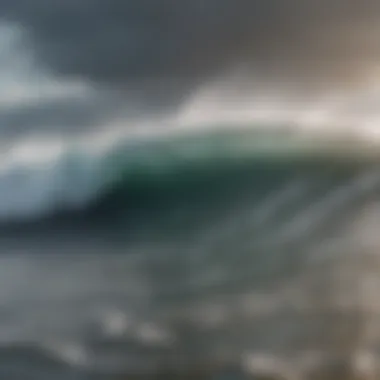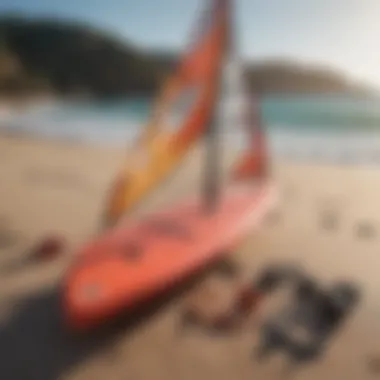Mastering Wind Surf Weather for Optimal Performance


Intro
Windsurfing isn't just about standing on a board with a sail; it's an art form that dances between the wind, water, and your skill level. Understanding how weather, particularly wind conditions, affects this thrilling sport is paramount for both novices and seasoned windsurfers. As you craft your plans for a day out on the water, the question looms large: What does the weather have in store for me?
Navigating the intricacies of wind patterns can mean the difference between a day of exhilarating rides or a frustrating experience. In this guide, we will delve into the essential aspects of windsurf weather, dissecting everything from the specifics of what constitutes favorable conditions to tips on making informed decisions before you hit the waves. If you want to take your windsurfing to the next level, buckle up; we’re about to embark on an insightful journey through the realms of wind, weather, and ride-ready strategies.
The Importance of Weather in Windsurfing
When it comes to windsurfing, the weather is more than just a backdrop; it is the very canvas upon which every thrilling ride is painted. Understanding how weather impacts windsurfing is crucial for anyone looking to make the most of their time on the water. The variability of wind conditions can dictate the enjoyment and safety of a windsurfing session, making weather knowledge an indispensable tool for enthusiasts.
Understanding the Link Between Wind and Surfing Conditions
Windsurfing relies heavily on the wind, and the relationship between the two is intricate. The wind’s speed and direction directly influence wave height, water current, and the overall ride experience. For example, a gentle breeze may coax a smooth ride, perfect for beginners, while a strong gust can create thrilling conditions for the adventurous souls seeking that adrenaline rush. Knowing how to read the wind can mean the difference between a leisurely afternoon on calm waters and an exhilarating journey through powerful swells.
In essence, wind speed can be categorized into several ranges, significantly affecting your ability to control the board and sail:
- Light Wind (less than 10 knots): Ideal for beginners. It's easier to learn the basics but can limit speed.
- Medium Wind (10-20 knots): Great for average enthusiasts. Acceleration improves, and it’s easier to perform tricks.
- Strong Wind (20+ knots): Suitable for experienced windsurfers. It demands skill and control, but the thrill can be unmatched.
Understanding these wind nuances helps you align your skills with the conditions out there, enhancing both safety and fun on the water.
How Weather Patterns Affect Equipment Performance
Every windsurfer's setup, from the board to the sail, has its own performance characteristics influenced by weather patterns. Take, for example, how temperature and humidity can impact sail material. Warmer air can make sails more pliable while cooler conditions may stiffen them. This change can subtly affect how you manage your equipment.
Moreover, the dynamics of various weather patterns must be taken into consideration:
- Storm Systems: Bring dramatic shifts in wind conditions. While they can create exciting surfing opportunities, they can also present risks.
- High-Pressure Systems: Usually create uniform and stable winds, providing fantastic conditions for windsurfing.
- Low-Pressure Systems: Can lead to unpredictable gusts and shifts in wind direction, demanding great adaptability from the windsurfer.
Thus, understanding these factors can help you not just choose the right gear but also make informed decisions about venturing out on certain days. Being able to predict how your equipment will perform in varying conditions allows one to make adjustments, ensuring safety and maximizing performance.
"Weather conditions are a windsurfer's best friend or worst enemy. Understanding them gives you the edge."
Key Weather Elements for Windsurfing
Understanding the key weather elements for windsurfing can make the difference between a thrilling ride or a risky venture. Having a solid grasp of wind speed, temperature, and cloud cover isn't just for meteorologists; it’s crucial for anyone looking to glide across the waves with confidence. These elements affect not just the enjoyment of your sport but also your safety. So, let’s break them down.
Wind Speed and Direction: What You Need to Know
Wind speed and direction serve as the backbone for any windsurfing outing. A gentle breeze might feel lovely while sipping a drink on a beach chair, but out on the water, that same breeze can create slightly different conditions. For the uninitiated, wind speed is typically measured in knots; one knot equals roughly 1.15 miles per hour.
When you’re planning your session, consider the wind speed. Light winds, around 5-10 knots, can be perfect for beginners or those just wanting to cruise. Intermediate windsurfers often thrive in winds between 10-20 knots, allowing for daring maneuvers without losing control. For the experienced thrill-seekers, speeds above 20 knots provide enough punch for high jumps and sharp turns, but also come with risks.


Besides speed, direction is equally important. Winds from the land (offshore winds) can lead to flat water that is more beginner-friendly, while onshore winds can create choppy conditions, affecting navigation and control. Knowing how to read wind direction and speed can enhance your experience dramatically, transforming a lazy afternoon into an exhilarating adventure.
Temperature and Its Impact on Water Conditions
Temperature isn't just about comfort; it significantly influences water conditions and equipment performance. Warmer water can cause wind to rise, which might increase the likelihood of gusty conditions. This shift in elements is crucial when planning your gear; lighter sails may be needed if the temperature is higher and winds are consistent. Conversely, cooler temperatures might call for heavier, more stable equipment that can handle sudden shifts in wind patterns.
Additionally, if the air temperature is significantly lower than the water temperature, it can lead to thick haze and reduced visibility. This situation can make finding your way around or spotting potential hazards tough; thus affecting overall safety. You'll want to make sure you come equipped not only with your windsurfing gear but also some form of temperature monitoring system.
Key takeaways include:
- Warmer water can lead to gustier winds.
- Gear adjustments may be necessary based on air and water temperatures.
- Visiblity plays a big role influenced by temperature differences.
Cloud Cover and Its Effect on Visibility
Cloud cover can easily influence every aspect of your windsurfing experience. Overcast skies often bring about different wind patterns and can create tricky conditions for both visibility and navigation. Multiple layers of clouds can indicate unstable weather, which might precede sudden changes like gusts or even rain. This can turn a sunny day into a whiteout situation in minutes.
In addition, flat light caused by cloud cover alters how you perceive the water surface, hiding bumps and swell that might make for a rougher ride. So, if you spot dark clouds on the horizon, you might want to pack it in for the day.
It's not just the immediate effect of clouds; predicting long-term weather behavior can help you make wise decisions about whether to hit the water or stay ashore. Always keep an eye on the skies and trust your instincts.
“Understanding these key elements can vastly improve your windsurfing experiences and your safety. Make the information your ally for memorable sessions.”
In summary, wind speed and direction, temperature, and cloud cover are pivotal elements that should never be overlooked. By keeping informed about these weather factors, you're not just boosting your chances for an adrenaline-pumping adventure – you're ensuring your time on the water is both fun and safe.
Wind Patterns and Surf Locations
Understanding wind patterns is crucial for any windsurfer, whether you're just starting out or you're a seasoned pro. The interplay between location and wind direction can make or break your experience on the water. It’s not just about feeling the breeze; it's about knowing where to find it and how to use it to your advantage. Navigating these factors can lead to thrilling rides or frustrating trips—knowing the ropes means you can maximize your time on the board and minimize any headaches.
Identifying Ideal Locations for Windsurfing
Choosing the right spots can be somewhat of an art, and it often comes down to familiarizing yourself with local wind patterns. Here are some essential points to consider when scouting windsurfing locations:
- Geographical Features: Hills, mountains, and cliffs can affect wind flow significantly. Being aware of these elevations allows a windsurfer to predict how wind patterns might shift in specific areas. For instance, a beach located near a large cliff might experience stronger gusts on windier days than one without such features.
- Wind Consistency: Some beaches provide consistent winds, perfect for windsurfing, while others may be gusty. Look for locations with prevailing winds; these are often listed in various windsurfing forums and websites.
- Safety Zones: Understanding where you can safely windsurf is key. Always check if there are lifeguards present, and be mindful of rocky areas or heavy boat traffic. You’d rather avoid those nasty surprises that can leave you swimming more than surfing.
Local knowledge can be invaluable; joining forums or community groups can help you discover those hidden gems—and might even save you a trip to a less favorable spot.
Seasonal Variations in Wind Conditions
Wind conditions, much like the swells, can vary dramatically with the seasons. Each season brings its own character, effectively shaping the surfing experience. Here are some observations worth noting:
- Summer Months: Generally, summer can bring warm temperatures, but not all spots are blessed with consistent winds. Often, warmer weather leads to thermal winds which can pick up in the afternoon after a slow start in the morning. Plan your sessions accordingly—waiting until noon might just give you that perfect wind.
- Winter Winds: Known for being stronger and more stable in certain regions, winter can be a delight for the more seasoned windsurfer. However, cold waters and frigid air mean you’ll need appropriate gear to keep you comfortable.
- Transition Seasons: Spring and fall are a mixed bag. Winds might be more unpredictable during these periods; local wind patterns can shift rapidly as temperatures fluctuate. Monitoring weather forecasts during these times is essential, as conditions can change within hours.
"Knowledge is key when it comes to windsurfing; the right location can transform your ride."


Ultimately, equipping yourself with knowledge about wind patterns and surf locations is only part of the puzzle; mastering these aspects can provide the thrill of a lifetime.
Advanced Weather Forecasting Techniques
When it comes to windsurfing, understanding weather patterns isn’t just a neat party trick; it’s an essential skill that can mean the difference between a thrilling ride and a disastrous day on the water. With the right forecasting techniques, you can spot favorable winds, recognize dangerous conditions, and ultimately make informed decisions that enhance your windsurfing experience.
In this section, we will dive into the intricacies of reading weather maps and exploring various mobile apps that help forecast windsurfing weather. This knowledge not only empowers you but also puts you in a better position to enjoy your time out on the water.
Reading Weather Maps: A Necessary Skill
Weather maps are like the treasure maps of the windsurfing world. Understanding these maps is invaluable for anyone serious about the sport. They provide crucial information about wind speed, direction, and even upcoming weather systems.
- Types of Maps: Recognizing the different types of weather maps—such as surface maps, radar maps, and satellite images—is vital. Each serves a specific purpose and can reveal varying details about conditions affecting your session.
- Key Elements: Familiarize yourself with isobars, which are lines that connect points of equal pressure. Closely packed isobars indicate strong winds, while widely spaced ones suggest lighter breezes. Understanding these symbols can help you gauge whether it's worth hitting the water.
- Trend Analysis: Learn to look at trends over time. A single weather map might tell you what's happening at a particular moment, but understanding seasonal trends can make you a forecasting ace.
Developing this skill requires practice, so don’t be afraid to spend some time poring over different maps before heading out. A good grasp of these tools can make your trips to the shore a lot more productive.
Utilizing Mobile Apps and Tools for Accurate Forecasts
In our tech-savvy world, harnessing mobile apps can drastically improve your forecasting game. Apps not only provide real-time updates but also keep you informed about sudden changes in weather conditions.
- Popular Apps: Consider apps like Windy, SailFlow, and iKitesurf. Each offers unique features tailored to wind sports, showing everything from wind speed and gusts to wave heights.
- Notifications: Set up alerts through these apps to get notified when conditions become favorable. This can be crucial, especially if the weather changes on a dime.
- Community Feedback: Many windsurfing apps come with community features that allow users to share their conditions and reviews. Tapping into local knowledge can help you know where to go and when to hit the water.
Investing a little time to familiarize yourself with these tools can elevate your game by providing information that’s direct and actionable. Remember that being well-informed is part of the thrill of the sport.
"Knowledge is Power!"
Use every bit of knowledge you acquire about weather forecasting to make your windsurfing experience safe and enjoyable.
Windsurfing Safety and Weather Conditions
When it comes to windsurfing, safety is paramount. You'll find that wind patterns, visibility, and sudden weather changes can make or break your time on the water. Recognizing the significance of these conditions isn't just a smart move; it can quite literally save your life. Before you drop that sail and start carving out your path, it's worth considering how various weather conditions affect your windsurfing experience.
Factors such as wind strength, the size of the waves, and even changing tides can turn a fun outing into a hazardous situation. Windsurfers must be attuned to the environment and ready to adjust their plans accordingly. Ultimately, understanding these dynamics can make your adventures all the more enjoyable and safe.
Recognizing Dangerous Weather Patterns
Knowing how to spot dangerous weather patterns is perhaps the lifeline for every windsurfer. Imagine you’re out there, the kite is soaring high, and suddenly the wind picks up like a freight train. What to do? Being familiar with certain weather signs can indicate whether it's time to head back ashore or fight the frustrating urges to stay out. Familiarize yourself with some tell-tale signs:
- Darker Skies: If the clouds turn from fluffy white to ominous gray, it’s likely that a storm is brewing.
- Rapid Wind Shifts: When the wind changes direction quickly, it can signal unpredictable conditions ahead.
- Increase in Wind Speed: If you notice the wind ramping up unexpectedly, especially during a sustained session, reevaluation is a must.
Staying alert to these signs not only keeps you safe but also enhances your overall experience.
Preparing for Sudden Weather Changes
Even the best-laid plans can go awry. Weather can flip like a pancake—what began as a clear blue sky can morph into a tempest in mere minutes. So, how do you get ready for sudden weather changes?


- Check Forecasts Regularly: Before heading out, look at local weather reports. Apps can be insightful, providing real-time updates on conditions.
- Pack Emergency Gear: A quick-dry towel, a backup buoyancy vest, or even a small whistle can be lifesavers. Remember, it’s better to be over-prepared than underprepared.
- Know Your Limits: Always sail within your abilities. If conditions look questionable or your gut feelings whisper doubt, it might be time to call it a day.
"It's not just about catching the perfect wave; it's about knowing when to call it quits."
By understanding the significance of recognizing dangerous weather patterns and preparing for sudden changes, you enhance both your safety and enjoyment while windsurfing. Each outing is an opportunity to learn and grow while respecting the forces of nature at play.
Psychological Aspects of Windsurfing in Varied Weather
When we think about windsurfing, the image is often one of physical challenge and outdoor adventure. However, the psychological dimensions of windsurfing in different weather conditions hold equal weight in determining a windsurfer’s success and enjoyment. For any enthusiast, understanding these elements can be decisive. The mental game involves preparation, adaptability, and confidence, which can significantly influence performance and safety. This section dives into those critical psychological aspects.
Mental Preparation for Challenging Conditions
Mental preparation prior to hitting the water in challenging conditions cannot be overstated. Windsurfers often face a reality where they must adapt swiftly to ever-changing weather. Those who can mentally frame these challenges often find themselves gaining the upper hand.
- Visualizing Scenarios: One technique is visualization. Imagine yourself navigating those waves before you even step on the board. Visualizing the actions you will take during strong winds or rough waters can prepare your mind for the real deal. This helps ground your thoughts when the conditions become less than favorable.
- Setting Clear Goals: Having set goals also plays a vital role. Are you there to improve a technique, enjoy the thrill, or safely navigate through a storm? Knowing your aim keeps your mind focused amidst fluctuating weather elements.
- Breath Control: Implementing breath control exercises may be small but can have a profound impact. Not only does it reduce anxiety, but it keeps your mind alert and ready. Taking slow, deliberate breaths can anchor you, allowing clearer thinking in unpredictable situations.
Here’s a crucial piece of advice: "The wind may howl like a banshee, but a prepared mind can turn chaos into a dance.”
Building Confidence in Unpredictable Weather
Confidence is key when out on the water, and unpredictable weather can quickly erode that confidence for many. Here are some strategies to help bolster your self-assurance, enabling you to tackle forecasted conditions with a firm grip.
- Start with Small Wins: Don’t feel pressured to jump into the biggest waves straight away. Begin in manageable conditions that give you a sense of control, then gradually build up to more challenging scenarios.
- Learn from Experience: Every session offers newfound knowledge. Keep a journal to track your feelings, thoughts, and results. Reflecting on past triumphs and setbacks helps in building a mental toolkit for future windsurfing endeavors.
- Embrace the Unknown: Learning to embrace uncertainty can be liberating. The more you respect the unpredictable nature of windsurfing, the easier it becomes to flow with it, just as water conforms to the shape of the vessel navigating through it.
By nurturing your confidence through experience and embracing the unpredictable, you'll find that weather fluctuations can transform from obstacles into opportunities.
For those passionate about windsurfing, mastering this mental aspect creates not just a better experience on the water but a more enriching time overall, allowing you to enjoy every twist and turn that the weather presents.
The Future of Windsurf Weather Forecasting
Windsurfing is an exhilarating sport, one that heavily relies on precise weather forecasting. As technology advances, the quest for accurate wind predictions becomes more crucial. Understanding the future of windsurf weather forecasting isn’t merely an academic exercise; it is about the safety, enjoyment, and overall experience of the windsurfers. Embracing innovations in tracking systems and methods allows windsurfers to make informed decisions out on the water. With tools that provide timely and reliable data, enthusiasts can navigate unpredictable conditions while pushing their limits.
Innovations in Weather Tracking and Prediction Technologies
The realm of weather tracking has seen remarkable developments in recent years. One might say that we are living in a golden age of real-time data collection. The use of advanced sensors and satellites is vital. For windsurfers, this means not just knowing which way the wind blows, but also predicting how it will change throughout the day.
Key innovations include:
- Drones: Equipped with specialized tools, drones can survey vast areas, gathering wind data from multiple altitudes. They offer a bird’s-eye view that was previously difficult to obtain.
- Mobile Technology: Apps now employ real-time data, allowing users to check conditions instantly. These apps aggregate data from different sources for comprehensive forecasts.
- Remote Sensing: Technologies like Lidar can assess surface wind speeds without needing traditional technology. This brings a new level of precision to forecasting.
These innovations are not just for high-end windsurfing; even amateurs can reap the benefits. Access to crucial weather data promotes safety and enhances the fun.
The Role of Artificial Intelligence in Weather Forecasting
Artificial intelligence is reshaping various fields, and weather forecasting is no exception. AI algorithms analyze daunting amounts of data much faster than humans ever could. For windsurfing, this means predictive modeling based on historical patterns, current conditions, and upcoming systems.
Some key points to consider:
- Machine Learning Models: These models can predict wind patterns by analyzing past events. They make recommendations based on probabilities, which could lead to better forecasting.
- Data Integration: AI can integrate information from multiple sources, such as weather stations, satellites, and ocean buoys, giving a holistic view of conditions.
- User-Specific Forecasts: With AI, forecasts can be tailored for specific locations and individual preferences. This collaborative approach between windsurfers and technology enhances the overall experience.
"The future of windsurfing forecasting rests not only on technology but on how we adapt and use these tools consonantly."
Adopting these technologies doesn’t just mean a better ride; it also implies that windsurfers can focus more on the joy of the sport rather than guessing what the weather might throw their way. The intersection of technology and sport provides the possibility of a safer, more enjoyable windsurfing experience.







